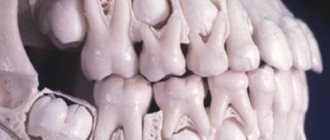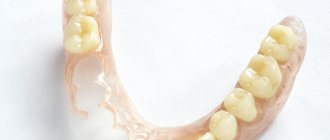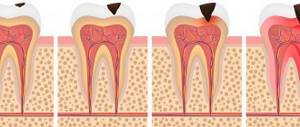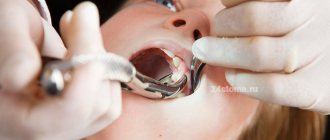The procedure of silvering teeth is the impregnation of areas affected by caries with silver, which strengthens dentin and enamel. In addition, silver disinfects the affected areas, eliminating cariogenic microorganisms, as a result of which the development of caries is suspended.
Most doctors prescribe silvering exclusively for children under 3 years of age who do not allow the dentist to cure the tooth. In most cases, the doctor manages to come to an agreement with older children, but much still depends on the dentist’s ability to find a common language with the little patient, calm him down and convince him that it won’t hurt. If the child is not afraid and fulfills the doctor’s requirements, then installing a filling will be a much more effective means in the fight against caries.
The development of caries in young children occurs much faster than in adults. First of all, carious formations affect the central incisors (mainly their front surface) and fourth teeth.
In children, caries, as a rule, is cervical, that is, covering the neck of the tooth with adjacent areas. A carious formation that appears in the first year of a baby’s life will develop to such an extent by the age of 2.5 that the crown of the tooth breaks off. Often caries is accompanied by the formation of fistulas and lumps, which indicates a purulent process occurring in the upper regions of the roots of the affected teeth.
Features of the procedure
Silvering teeth in children is not a new thing in dentistry; it has been practiced for several decades. The method is as follows: a solution containing active silver salts is applied to a cleaned surface damaged by caries.
Interacting with enamel particles, the drug forms a film consisting of noble metal phosphates, clogging the dentinal tubules. The surface of the tooth at the site of application of the solution becomes dense, less vulnerable to the negative effects of acids and microorganisms in the oral cavity.
The procedure is indicated in the initial stage of caries development, when the stains on the teeth are white or yellowish. In color and texture they are similar to chalk inclusions. In the case of an advanced form, when the soft tissues of the tooth (pulp) are affected, other treatment methods are used.
Flaws
Today, modern dentists note the effectiveness of the silvering method only in cases where the child suffers from minor dental caries and has genetically determined healthy teeth.
The described technique will not be able to cope with complex, deeper lesions of the enamel. The active ingredients cannot resist the negative effects of acids.
However, the main disadvantage of silvering baby teeth is that the enamel turns black, which is the result of a chemical reaction between the enamel and the silver particles. Quite often, deterioration in the aesthetics of a smile creates psychological discomfort for the child.
In addition, some of the disadvantages of the procedure are noted by the experts themselves:
- Before applying the solution, it is necessary to thoroughly prepare the surface of the teeth, which requires time and perseverance from the child.
- The resulting film does not protect the chewing surface of the teeth; on the contrary, it sometimes becomes a barrier to diagnosing problems of the oral cavity.
- The silvering procedure alone is not enough to obtain the desired result.
The listed disadvantages of the technique force parents of children to look for, albeit more expensive, but effective ways to solve oral problems at an early age.
Advantages of the method
In addition to the absence of pain, silvering teeth in children has many more advantages:
- Treatment is carried out with an inexpensive drug and in a short time, which reduces the cost of the procedure.
- The solution is safe for children's bodies and is suitable even for infants.
- Preserves the development of caries.
- There is no risk of injuring the baby and creating a fear of treatment at the dentist.
Painlessness during the procedure is one of the main advantages of the method. The drug is applied without the use of dental instruments, using a soft applicator. This is very convenient for children 2–3 years old; it is at this age that caries first makes itself known.
Prevention of caries in primary teeth. Silvering or fluoridation – which is better? Dentists answer
On baby teeth, the enamel is thinner, and the pulp chamber inside is wider and larger than in permanent teeth. Therefore, caries in children progresses at lightning speed. A small brown spot very quickly grows to the size of a full-fledged carious cavity, and the lesion spreads to the pulp - the neurovascular bundle. As a result, pulpitis develops, that is, inflammation of the nerve, and this inevitably entails many serious symptoms, including severe pain. To avoid such unfavorable developments, parents should closely monitor the condition of their child’s oral cavity. While caries is at the white spot stage, the situation can still be reversed, and prevention methods help with this - silvering or fluoridation of baby teeth. Read more about each method, its pros and cons, further in the article.
Minuses
- If you neglect to thoroughly clean your teeth before the procedure, it may not give the desired effect.
- After silvering at the site of application of the drug, the enamel acquires a stable dark or black color if solutions produced in Belarus and Russia are used. Treatment with Japanese “Saforaid” gives the teeth a light gray or brownish tint. It is impossible to return the previous whiteness. The blackening of teeth in the photo before and after silvering often makes parents doubt the need for the procedure.
- Treatment is time-consuming and the process cannot be completed in one day.
- There is a risk of pulp burns and allergies.
- Silver plating is not suitable for chewing teeth.
Indications and contraindications
The decision on the advisability of using a silver solution is made by the doctor. Indications for the procedure are:
- Carious spots in the initial stage of the disease.
- Microcracks and chips on the tooth surface.
- Sensitivity and obvious anxiety of the child, making it impossible to use the drill.
- For children living in areas with low levels of fluoride in water and food, teeth silvering may be prescribed as a preventative measure.
In some cases, the method is used to increase the service life of the filling.
If parents are in doubt whether or not to silver their baby’s teeth, they need to take into account contraindications, which are:
- Large degree of tooth damage: caries in the middle and deep stages.
- Living in an area characterized by high fluoride content.
A snow-white smile with spraying: a health risk or active protection?
Spraying enamel on teeth is a full-fledged independent segment in the aesthetic dentistry industry. The method is widely used in dental prosthetics, as well as in restoring the visual attractiveness of a smile after aggressive treatment. Spraying refers to the uniform application of a special specific paint to the surface of the teeth, after which it firmly “sticks” to them and creates the effect of a natural snow-white smile.
Content:
I must say, the procedure is not so popular in itself. A person with a completely healthy oral cavity resorts to completely different methods of whitening, ranging from laser to medication.
But if the enamel is destroyed on its own, or a person needs unattractive dentures, spraying creates the greatest demand among dental patients. Some prefer even exotic techniques of spraying enamel on their teeth to make them platinum or gold. But first things first.
The process of destruction of enamel leads not only to numerous diseases of the oral cavity, but also to a significant decrease in the aesthetics of a smile. And alas, banal teeth cleaning cannot cope with this destructive process, even if it is performed by a professional on an outpatient basis.
However, there is a new hygienic procedure that involves not only effective sanitation of the oral cavity, but also medicinal spraying of concentrated calcium onto the surface of the teeth. Previous cleaning techniques, for example, ultrasonic, were aimed only at eliminating the stone and subsequent application of fluoride-containing paste to the surface of the bone tissue.
This method really helped to avoid the formation of carious cavities, but it only protected dentin, without affecting the deep structures.
Modern cleaning technologies are suitable not only for whitening, but also for deep restoration of tooth enamel. During the procedure, the dentist applies a special solution containing calcium in the optimal amount.
In luxury segment blades, exclusive products are used for this procedure, for example, pearl powder. As a result, the tooth is saturated with calcium and becomes much less susceptible to various diseases.
In addition, the surface is polished, which creates the effect of a real Hollywood smile. The powder granules have a specific structure and do not contain hard abrasives, which eliminates an increase in sensitivity after using the method.
As a result of cleaning with calcined coating, the patient receives:
- A charming snow-white smile;
- Healthy shine and ideal density;
- Minimum sensitivity threshold after applying the method;
- Strengthening teeth and prolonging their healthy state;
- Reliable protection against caries, pulpitis and other destructive processes.
It must be said that not every average patient can afford such a procedure. It, like standard professional cleaning, is recommended to be performed regularly, at a certain time interval.
However, it is she who provides high-quality oral care, so admirers of Hollywood smiles should still spend money on it.
Each clinic uses different formulations when spraying teeth to make them whiter. If you decide to resort to such a procedure, specify which particular remedy will be used in your case.
The composition itself is applied sequentially, mainly using a laser. This procedure is completely painless and safe, and therefore arouses genuine interest among numerous clients of aesthetic dental offices.
Sprayed crowns are standardly used for dental prosthetics. However, standard implants may not be suitable for everyone, because the color of the “native” enamel is as unique as everything in the human form.
Agree, a snow-white crown will contrast with nearby teeth of a grayish or yellowish tint. It is for this reason that spraying is used simultaneously on all teeth, at least those that are exposed when smiling.
Spraying tooth enamel with zirconium is now extremely popular. The fact is that zirconium dioxide crowns themselves are quite expensive.
However, with a limited budget, it is possible to use the same material on already installed metal crowns. Crowns on teeth coated with high-quality zirconium are absolutely no different from the “healthy” part of the mouth.
In addition to the aesthetic part, this method ensures the creation of a dense zirconium layer on the pins themselves, thereby helping to protect against metal penetration into the oral cavity. But the installation of metal prostheses often leads to rejection of foreign bodies and the development of allergic reactions.
If it happens that you have lost your teeth and you need to restore them without compromising your beauty, the best option for you is dental prosthetics with spraying. Metal crowns and bridges do not look very attractive, and this is no secret. And if you cover them with a dense substance that imitates healthy, polished enamel, the appearance will not only be restored, but also significantly transformed.
Remember the first prosthetics that we all saw in the 90s? They were gold teeth, i.e. crowns with gold plating. This is not to say that this method was cheap, but it was used by everyone who had lost teeth.
Despite the real gold sparkling in the mouth, this method was not visually acceptable. Although, to be honest, some outrageous people deliberately resort to it today, when dentistry, in particular aesthetic dentistry, has been developed, it would seem, to its evolutionary limit.
There were also steel prostheses. They were cheaper, but much stronger. In addition, they caused almost no allergic reactions and problems with gum inflammation.
Modern metal simulators of teeth with coating are in no way different from their healthy and intact “neighbors”. Prosthetics takes place in several stages: a pin is created, then an impression is made, and only after that a special composition is applied to the frame, creating the effect of a full-fledged tooth.
Titanium nitride is often applied to coated iron dental prostheses. This procedure is carried out using the vacuum-plasma method. As a result, the tooth looks as if it was molded from gold. Some patients contact clinics with a request to cover only part of the tooth with gold. This is impossible, since the entire prosthesis is sprayed on both sides.
Spraying enamel can be useful to you in several situations. If prosthetics has taken place, this procedure will become most relevant. You can also safely resort to it to strengthen natural enamel or safely whiten teeth. Whatever your whim or need, we strongly recommend that you contact an experienced and competent specialist.
Due to the high demand for dental services, many private clinics and dental offices have appeared, employing newcomers and trainees.
If you want to get a decent, high-quality result, seek help only from highly qualified specialists. Take care of your oral health and let your smile always shine with health!
mjusli.ru
Technique of the procedure
The method of silvering has not undergone any changes over a long time. Impregnation of primary teeth is carried out in the following order:
- Selection of the drug. The list of medications used in this method is extensive. The main active ingredient included in the solution is 30% silver nitrate. In addition, you need a special Vaseline-based oil that protects the gum mucosa during processing.
- Cleaning the enamel with brushes and applying abrasive paste. It is performed to free the surface of the tooth from plaque, microorganisms and dead particles.
- Rinsing the mouth from the toothpaste with water.
- Protection from saliva using cotton swabs, drying the mouth with warm air.
- Treating gums with Vaseline oil to prevent burns.
- Applying a solution containing silver using a dental applicator (microbrush). The treatment is carried out locally, avoiding contact of the drug on the gums. After a few minutes, the procedure is repeated, then the reducing agent is applied.
- At the final stage, the silvered surface is dried with warm air. A sign of a correctly performed procedure is the appearance of black enamel at the site where the solution was applied.
It is not recommended to rinse your mouth, eat or drink for 40–60 minutes after treatment.
Drugs and costs
The main preparations for silvering teeth in children include the domestic “Argenat” and “Saforaid”, produced in Japan. The first solution is available in one- and two-component forms. Contains silver fluoride diamine. When interacting with calcium ions, it forms calcium fluoride and silver orthophosphate, which have a bactericidal effect.
It is believed that the Japanese drug contains an ideal combination of fluorine and silver ions. Its disadvantage is its high price, an order of magnitude higher than that of Argenat.
The cost of the service depends on the degree of damage, location and level of the clinic, and the drug used. The lower price threshold starts from 30 rubles and ends in the range of 680–800; on average, the procedure costs 150 rubles per tooth. In dental clinics, services for children can be provided free of charge, if this is provided for by the Territorial Compulsory Medical Insurance Program.
How often to do
Prevention and treatment of caries is a long process. Silvering of teeth in children is carried out at intervals determined by the doctor. The frequency of visits depends on the following factors:
- Method of feeding the child: breastfeeding, artificial feeding, are there cases of night feedings.
- Baby's age. After 3 years, it is advisable to resort to dental treatment using fillings.
- The level and ability of parents to carry out hygiene procedures.
- Condition of tooth enamel.
- The number of affected teeth and the degree of caries development.
Typically, teeth resilvering requires a follow-up visit within a week and three to five dental visits per year.
Reasons for the development of early childhood caries -
As we said above, any means of treating caries will not be very effective if parents are not ready to implement or control the quality of oral hygiene in the child. It will also not be possible to achieve a positive result if you allow your child to eat between main meals - sweets, flour, starchy foods, drink sweet soda, or sweet or sour juices. Thus, without following a diet and controlling the consumption of easily digestible carbohydrates, the effect of treatment will tend to zero.
Our website has professional reviews on oral hygiene in children that will help you avoid the risk of developing caries in your child altogether. You can write your questions in the comments to this article. And we hope that our article: Silvering teeth for children reviews - was useful to you!
Sources:
1. The author’s higher professional education in dentistry, 2. Based on 20 years of personal experience as a dentist, 3. The European Academy of Paediatric Dentistry (EU), 4. National Library of Medicine (USA), 5. “Pediatric therapeutic dentistry. National leadership" (Leontyev V.K.).
Is it possible to do silver plating at home?
At first glance, there is nothing complicated or dangerous in the procedure. But, despite the fact that the child feels calm at home, applying the drug on his own is strictly prohibited, and here’s why:
- It is difficult for a person far from medicine to determine the extent of enamel damage. Penetration of silver solution into soft tissue can lead to pulpitis.
- If silver solution gets on the mucous membrane as a result of inept actions, it causes a burn.
- Without special skills and tools, it is difficult to properly clean the surface of a tooth; unremoved plaque will negate all efforts.
- If an allergic reaction occurs, medical attention may be needed immediately. It is difficult, often impossible, to provide it at home.
Psychological side of the issue
Children don't often look in the mirror and think about what color their teeth should be. But black spots can be indicated by other kids who keep the child company in kindergarten, on the playground or in a development center. Therefore, before silvering a tooth, it is advisable to talk to the baby and tell him what changes are coming and why this is necessary.
The child must understand that the “silver” on the enamel reliably protects it from the harmful effects of infection. It doesn’t matter what teeth that have begun to turn black look like, the main thing is that if you don’t take action, they can start to hurt and fall out.
If a child is teased, he may experience stress. To repel ridicule, the baby can answer that his teeth have silver, not black, marks.
Important! When asked by a child when the blackness will pass, it is better to answer honestly that the dark spots will persist until new incisors and molars begin to grow.
Are you planning to have your child's teeth silvered?
- Yes, I plan 58%, 14 votes
14 votes 58%14 votes - 58% of all votes
- Don't know yet 29%, 7 votes
7 votes 29%
7 votes - 29% of all votes
- No, I'll choose another 13%, 3 votes
3 votes 13%
3 votes - 13% of all votes
Total votes: 24
21.09.2018
×
You or from your IP have already voted.
Why is it so important to treat caries of baby teeth in a timely manner?
Caries is one of the most common dental pathologies, leading to the gradual destruction of hard tissues as a result of the rapid proliferation of bacteria and harmful microorganisms. There are quite a few possible prerequisites for the development of the disease: from a love of sweets and insufficient hygiene to improper formation of tooth buds even at the stage of intrauterine development of the fetus. In any case, the problem is serious and requires timely treatment, especially if we are talking about primary incisors with a thin enamel layer.
Some parents mistakenly believe that treating temporary teeth is not necessary. Expecting their rapid replacement, they lose sight of a very important point: the pathological process quickly destroys hard tissues, leads to their rotting and at the same time inevitably spreads to the rudiments of permanent elements. As a result, they erupt with problems. In addition, neglected caries turns into pulpitis, which sometimes leads to the need for premature removal of the causative tooth. In this case, there is a serious risk of developing jaw abnormalities, which will subsequently require long-term orthodontic treatment to eliminate.
If the problem is not treated, you can lose your teeth
The development of caries begins with the appearance of a small pretty spot on the enamel - at this stage there is still a chance to save the situation and prevent further spread of the pathological process. To do this, dentistry performs a silvering procedure or prescribes a course of fluoridation. To understand what is best to choose for a child, it is worth considering in detail the pros and cons of each method.
Alternative methods
Medicine is developing rapidly, so many clinics offer other methods of painless treatment and prevention of caries. If there are contraindications to the silvering procedure, the following options can be used:
- Remineralization . The affected part is treated with fluoride-containing preparations by spraying, after which the tooth tissue becomes strong due to the formation of a mineral film. Unlike silver plating, fluoridation preserves the color of the enamel.
- Ozonation . It is a method of treating teeth with ozone. In the process, a significant part of pathogenic microorganisms is destroyed. Requires repeated repetition for greater effectiveness.
- Sealing tooth fissures . The method combines preventive and therapeutic effects. The tooth cavities are filled with a sealant-type agent, which prevents the subsequent development of the carious process. The drug also contains microelements and minerals necessary for enamel.
- Treatment with a drill . To make the process painless, pediatric dentists use ointments and sprays that have a local anesthetic effect. If the doctor is experienced and can establish contact with the child, the treatment will take place without pain and stress, and subsequently the child will not be afraid to have his teeth treated.
The listed methods are mainly suitable for children from 3 years old; their cost is much higher than the price of the silvering procedure.
Important! The choice of treatment method is influenced by many factors: how much the service costs, what the tooth looks like after it, whether the child hurts or not during treatment, and whether a durable coating is formed with each method. But a specialist must decide whether to silver a child’s teeth or not.
Alternative
Silvering is a method that, although effective, is quite outdated. Now there are a number of alternative ways to protect against caries and other diseases.
- Ozonation. This is a dental treatment that uses ozone. It has a tremendous antimicrobial effect. After this procedure, the infection dies, and caries stops in its development.
- Fluoridation (remineralization). A fairly popular technique in which teeth are treated with preparations that contain fluoride. This mineral is very beneficial for enamel. It strengthens it perfectly. A thin film of minerals is created on its surface. They are able to protect teeth from bacteria for a long time. But this method can be used after the child reaches the age of three.











